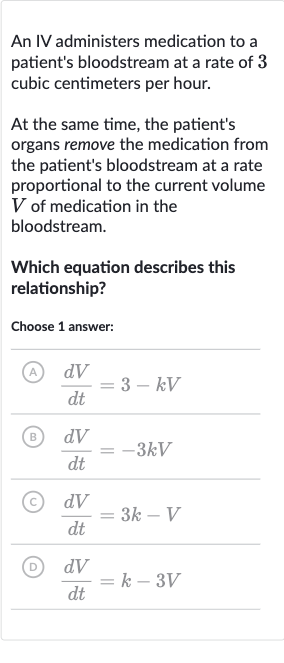AI tutor
Welcome to Bytelearn!
Let’s check out your problem:

An IV administers medication to a patient's bloodstream at a rate of cubic centimeters per hour.At the same time, the patient's organs remove the medication from the patient's bloodstream at a rate proportional to the current volume of medication in the bloodstream.Which equation describes this relationship?Choose answer:(A) B) (C) (D)
Full solution
Q. An IV administers medication to a patient's bloodstream at a rate of cubic centimeters per hour.At the same time, the patient's organs remove the medication from the patient's bloodstream at a rate proportional to the current volume of medication in the bloodstream.Which equation describes this relationship?Choose answer:(A) B) (C) (D)
- Understand the problem: Understand the problem.The IV administers medication at a constant rate of cubic centimeters per hour. At the same time, the patient's organs are removing the medication at a rate proportional to the current volume of medication in the bloodstream. We need to find the differential equation that represents this situation.
- Identify terms: Identify the terms of the differential equation.The rate of change of the volume of medication in the bloodstream over time, , is affected by two factors: the constant rate of administration and the rate of removal, which is proportional to the volume .
- Formulate equation: Formulate the differential equation.The rate of administration is a constant cubic centimeters per hour, so it is a positive term in the equation. The rate of removal is proportional to the volume , which means it should be represented as , where is the proportionality constant. Since the medication is being removed, this term should be negative. Therefore, the differential equation should have the form administration rate removal rate.
- Write equation: Write down the differential equation.The differential equation that represents the situation is , where represents the constant rate of medication administration and represents the rate of medication removal.
- Match with choices: Match the differential equation with the given choices.The correct differential equation is . This matches with choice (A) .
More problems from Compare linear and exponential growth
QuestionGet tutor help
QuestionGet tutor help
QuestionGet tutor help
QuestionGet tutor help
QuestionGet tutor help
QuestionGet tutor help
QuestionGet tutor help
QuestionGet tutor help
QuestionGet tutor help
